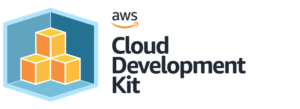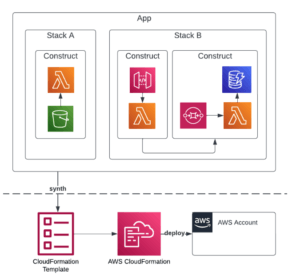AWS CDK: A Paradigm Shift in Infrastructure as Code
Efficiently managing cloud infrastructure is paramount for organizations navigating the complexities of modern cloud environments. As solution builders strive to streamline deployment processes, enhance productivity, and ensure consistent adherence to best practices, they encounter a significant challenge:
Traditional infrastructure management tools often diverge from the familiar paradigms of modern programming languages and concepts.
For years, development teams have grappled with the disjointed nature of infrastructure management tools. These tools were typically handled by operations teams, separate from standard development workflows. This disconnect has resulted in inefficiencies, inconsistencies, and a steep learning curve for managing cloud resources effectively.
However, a transformative shift is underway with the rise of Infrastructure as Code (IaC), offering a revolutionary approach to provisioning, configuring, and managing cloud resources through code. At the forefront of this revolution stands the AWS Cloud Development Kit (CDK), poised to bridge the gap between traditional infrastructure management and modern software development practices.
Background
Managing cloud infrastructure traditionally involved manual configurations or custom automation scripts, both of which were error-prone and time-consuming. Provisioning and configuration tools like Puppet, Chef, and Ansible provided better consistency and repeatability, but they were complicated to use and often relied on agents running in the infrastructure. This led to the emergence of Infrastructure as Code (IaC).
Infrastructure as Code (IaC)
Infrastructure as Code (IaC) revolutionizes cloud management by treating infrastructure provisioning as software development. Here’s how it delivers significant advantages:
Familiar Tools and Workflows: IaC integrates seamlessly with familiar developer tools like Git and workflows such as code reviews. This familiarity enhances collaboration and accountability within teams.
Consistency and Reproducibility: With IaC, deployments are consistent and reproducible across different environments, minimizing errors and ensuring confidence in deployments. This agility allows for faster feature delivery and greater value to users.
Agile Infrastructure Evolution: IaC facilitates the seamless evolution of infrastructure alongside feature development. This ensures alignment between infrastructure and application requirements, enabling teams to respond swiftly to changing needs.
Proximity to Application Code: By keeping infrastructure definitions close to application code, IaC enables easier management, troubleshooting, and versioning of infrastructure changes. This synchronization enhances efficiency and reliability in deployments.
Collaborative Culture: Embracing IaC fosters a collaborative culture by breaking down silos between development and operations teams. This collaboration promotes communication, alignment, and innovation across the organization.
Common Pain Points of Infrastructure as Code
Even though IaC has been a great step forward, the tools and frameworks supporting IaC have not been without their own pain points.

Domain Specific Languages: Tools like Terraform and AWS CloudFormation rely on domain-specific languages (DSLs) with limitations on expressiveness and abstraction.
State Management: Managing the state of deployed infrastructure can lead to conflicts and issues, especially in collaborative environments.
Provider Compatibility: Dependency on tool updates for compatibility with new AWS features can result in delays and limitations.
Enter the Ring: AWS CDK

AWS CDK addresses these pain points by providing a developer-friendly framework for defining cloud infrastructure using familiar programming languages like TypeScript, Python, and Java. Infrastructure as Code with REAL CODE! Leveraging the power of AWS CloudFormation under the hood, CDK offers a higher level of abstraction and expressiveness compared to traditional IaC tools.
Key Concepts of AWS CDK
Below outlines the most important AWS CDK concepts. For a detailed overview of AWS CDK key concepts checkout the AWS CDK Concepts in the developer documentation.

Constructs
Constructs in CDK represent cloud components such as Amazon S3 buckets, EC2 instances, or AWS Lambda functions. They allow developers to define infrastructure using object-oriented constructs, enabling code reuse and sharing. Constructs can be used to define higher level abstractions. For example: ApplicationLoadBalancedFargateService
Stacks
Stacks are units of deployment in CDK, representing a collection of resources that can be deployed together. Resources that should be deployed independently should live in different stacks.
Apps
At the highest level, a CDK application is called an App. These serve as containers for one or more stacks, facilitating the management of complex deployments.
Deployment vs Synthesis
In AWS CDK, the deployment process involves deploying stacks to AWS, while synthesis refers to the process of generating AWS CloudFormation templates from CDK code. This separation of concerns allows for greater flexibility and control over the deployment process.
Benefits of AWS CDK

Faster Deployment Speed
By sidestepping the limitations of traditional IaC tools, AWS CDK enables developers to ramp up deployment speed significantly. With familiar programming languages and higher-level abstractions, deploying infrastructure becomes more efficient and precise.
Enhanced Efficiency and Reliability
CDK streamlines cloud development by working with developers’ preferred tools and workflows. Because it leverages modern programming languages, developers can leverage their existing knowledge, IDEs and conventions, and they don’t need to learn a new IaC specific domain specific language. This includes things like linting and automated testing frameworks. Because it’s all code, CDK works in harmony with the version control systems and code review processes already used by developers. This helps foster high standards of quality and also reinforces the reliability of cloud deployments.
Support for Reusable Abstractions
Using CDK, developers can leverage the capabilities of modern languages to create powerful abstractions that encapsulate complex ideas. These abstractions can make it easier to reason about and understand the system. Developers can also craft reusable constructs that incorporate all of the best practices of AWS architecture and security. This not only helps other developers repeat and stay consistent with best practices, it also serves as canonical examples for preferred design patterns in the system.
AWS Native Solution
As an AWS native solution, CDK closely follows the evolution of AWS services and features. This ensures that developers have access to the latest capabilities offered by AWS, without the need to wait for tool updates or workarounds. Other tools, like Terraform, need to wait for features to become available before they can support them natively in the tool.
Type Safety and Unit Tests
CDK provides type safety and enables developers to write unit tests for their infrastructure code. This ensures that the resources being deployed have the correct characteristics and configurations, leading to more robust and reliable deployments.
Open Source Libraries
The open-source nature of CDK allows developers to leverage community-contributed libraries and solutions. For example, the AWS Solutions Constructs library provides pre-built, production-tested constructs for common use cases, accelerating development and reducing time to market.
Flexibility and Extensibility
With CDK, developers have the flexibility to define custom constructs and abstractions, tailored to their specific requirements. This allows for greater adaptability and extensibility in managing complex cloud environments. This also means you can build the things that AWS doesn’t readily provide.
Enhanced Collaboration and Knowledge Sharing
By embracing CDK, organizations can break down silos between development and operations teams, fostering better collaboration, and knowledge sharing. This leads to a more cohesive and efficient approach to cloud infrastructure management. That said, developers with a solid understanding of the underlying resources, constraints, and dependencies will be more effective when using CDK. For example, just because it’s fairly easy to stand up a Postgres Database in RDS doesn’t mean it’s straightforward to troubleshoot access issues from an application. Foundational knowledge of AWS networking, security, and permissions is still essential for development in AWS.
Comparison with Alternative Solutions
While there are various tools available for Infrastructure as Code, let’s look at a few in comparison with AWS CDK:
AWS CloudFormation
As a native AWS service, CloudFormation offers deep integration with AWS resources. However, it requires users to write JSON or YAML templates, which can be verbose and less readable compared to CDK’s programming language constructs. CDK provides a higher level of abstraction and expressiveness, making infrastructure definitions more concise and maintainable.
Terraform
Terraform, an open-source tool from HashiCorp, supports multiple cloud providers and uses its own declarative language for defining infrastructure. While Terraform offers flexibility and broad compatibility, it may have a steeper learning curve compared to CDK’s familiar programming languages. CDK’s tight integration with AWS services and developer-friendly approach make it a compelling choice for AWS-centric environments.
Azure Bicep
Microsoft’s Azure Bicep simplifies the authoring of Azure Resource Manager (ARM) templates using a domain-specific language (DSL). While Bicep aims to improve readability and maintainability for Azure deployments, it lacks the ecosystem and community support enjoyed by AWS CDK at this point in time. For Azure environments, it’s worth taking a look at Terraform and CDKTF before making a framework decision.
CDK for Terraform (CDKTF)
CDKTF is a library that generates Terraform configuration from constructs defined in familiar programming languages like Typescript, Go, Python, Java, and C#. It allows users to leverage the strengths of both CDK and Terraform, combining the familiarity of CDK’s programming model with Terraform’s robust execution engine and support for multiple cloud providers. However, CDKTF is still in its early stages of development and may not offer the same level of maturity and community support as AWS CDK.
Drawbacks and Considerations
While AWS CDK offers numerous benefits for managing cloud infrastructure, it’s essential to be aware of some potential drawbacks and gotchas:
Learning Curve
For developers who are new to AWS CDK or unfamiliar with the underlying AWS services, there may be a learning curve involved in understanding CDK constructs, APIs, and best practices. It’s important to allocate time for training and experimentation to fully leverage the capabilities of CDK. When we work with new customers and development teams at SpinDance, we address this early by sharing our expertise, and having at least a few CDK veterans embedded in the team.
Resource Naming and Management
CDK automatically generates resource names based on constructs and stack names, which may lead to complicated/unpredictable resource names or conflicts in certain scenarios. Careful consideration and manual naming conventions may be necessary to ensure consistency and clarity in resource naming.
Vendor Lock-in
As an AWS-native solution, AWS CDK may result in vendor lock-in, making it difficult to migrate to other cloud providers in the future. Organizations should carefully evaluate their long-term cloud strategy and consider the implications of vendor lock-in when adopting CDK.
Update Frequency
AWS CDK is a rapidly evolving framework, with frequent updates, new features, and improvements. While this demonstrates the commitment of AWS to the CDK ecosystem, it also means that developers need to stay up-to-date with the latest releases and best practices to take full advantage of CDK’s capabilities. If you are using any of the `alpha` releases from AWS Solution Constructs, be keen on watching for breaking changes as the solutions continue to solidify.
Closing Thoughts
AWS CDK represents a significant advancement for Infrastructure as Code, offering developers a powerful tool for managing cloud infrastructure with greater efficiency and ergonomics. By harnessing the benefits of CDK, organizations can accelerate their deployment processes, uphold best practices, and adapt to the rapidly changing cloud technology landscape.
So, go get your hands on it, take AWS CDK for a test drive and explore its capabilities and possibilities. Happy coding!
References
SpinDance Webinar: Unleashing the Power of AWS CDK for Software Developers: Learn about the benefits and intricacies of transitioning to AWS CDK for Infrastructure as Code. Discover the advantages, best practices, and real-world experiences shared by developers who have made the switch.
SpinDance Webinar: Building Better with AWS CDK – Real Work Applications and Examples: Explore practical use cases, design reusable constructs, master multi-environment configuration best practices, and delve into unit testing strategies for AWS CDK applications. Whether you’re a developer, cloud architect, or part of a DevOps team, this webinar will enhance your AWS CDK skills and elevate your cloud development expertise.
Official AWS CDK Documentation: The official documentation provided by AWS offers comprehensive guidance, tutorials, and reference materials for understanding and using AWS CDK effectively.
AWS CDK Best Practices: This resource outlines best practices and recommendations for designing, structuring, and implementing infrastructure using AWS CDK. It provides valuable insights for optimizing CDK-based projects for performance, reliability, and maintainability.
CDK Workshop: The CDK Workshop provides hands-on tutorials, examples, and exercises for learning AWS CDK concepts and techniques. It’s a valuable resource for developers looking to gain practical experience with CDK in real-world scenarios.
AWS Solution Constructs: AWS Solution Constructs is a collection of pre-built, production-tested constructs for common use cases in AWS CDK. These constructs provide ready-made solutions for common infrastructure patterns, accelerating development and reducing time to market.
Construct Hub: Construct Hub is a centralized repository of community-contributed CDK constructs, modules, and libraries. It offers a wide range of reusable components and extensions for building and managing AWS infrastructure with CDK.
Official AWS CDK Videos: A collection of videos, tutorials, and presentations covering various aspects of AWS CDK. These videos provide additional insights, tips, and best practices for getting the most out of AWS CDK.